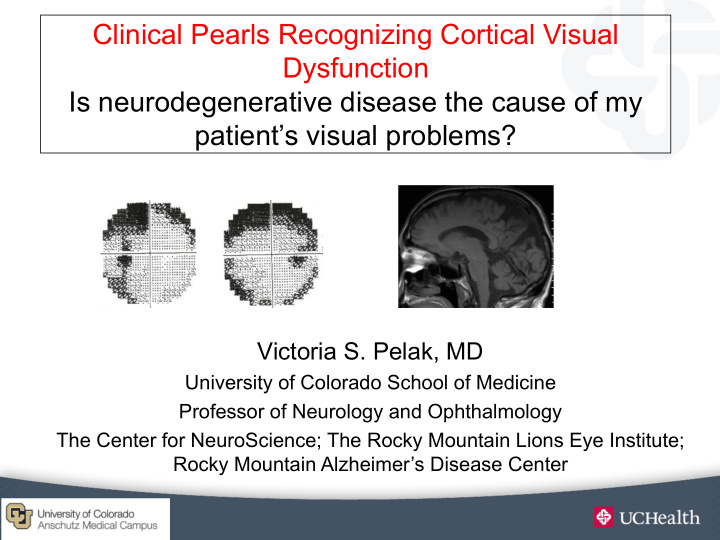



Clinical Pearls Recognizing Cortical Visual Dysfunction Is neurodegenerative disease the cause of my patient’s visual problems? Victoria S. Pelak, MD University of Colorado School of Medicine Professor of Neurology and Ophthalmology The Center for NeuroScience; The Rocky Mountain Lions Eye Institute; Rocky Mountain Alzheimer’s Disease Center
Financial Disclosures • Current Grant Funding: – Alzheimer’s Association – North American Neuro-ophthalmology Society • Royalties: Up-to-Date, Inc.
Neurodegenerative Dementing Diseases (NDD) 47.5 million Alzheimer’s Disease (AD) AD + Lewy Creutzfeldt-Jakob Cortical Visual Body Disease Regions Dementia (LBD) Corticobasal Degeneration Progressive Supranuclear LBD Palsy + LBD Parkinson’s Disease Dementia (PDD)
Neurodegenerative Dementia (NDD): Visual Dysfunction is Common • 33% Alzheimer’s Disease (AD) ü AD Neuroimaging Initiative ü visual >> memory dysfunction (Crutch et al. 2015) • 25% AD have atypical presentation ü present with visual or language dysfunction (Whitwell et al. 2012) ü Young onset (<65 years) spare https://en.wikipedia.org/wiki/Hippocampus
Signs and Symptoms of Visual Cortical Dysfunction Not very specific for the type of NDD Ø overall clinical picture provides specificity E.g. Lewy Body Dementia Criteria: • prominent visual cortical dysfunction • cognitive fluctuations, Parkinsonism, visual hallucinations, orthostasis, REM sleep behavior disorder Gowers 1886
Symptoms with 20/20 vision • Early (1-12 months) • Later (12-36 months) – Vague (repeated lens – Extensive list (next changes) slide) – “Blurred, difficult to focus, – Moderate to severe diplopia, problems judging impairment in function distances, can’t see ‘details’” – Affect job performance – Functional impairment – Driving impairment – Task specific ”I can’t see well while…” looking at • Late (>36 months) spreadsheets, using the computer, scrolling tv text, – Can’t see reading cursive – VA <20/40
Typed list presented at visit 1 by friend and family Look for symptoms of apraxia!
Signs: Visual Cortical Functional Anatomy Pelak 2009 Exp Rev Oph
Visual Cortical Function Modified from: S. Zeki, 1993 Spatial perception and action Basic V4 Color Face and object Motion recognition
Occipital: Striate/Extrastriate Regions (V1-V3) Decreased visual acuity • crowding • attention can play a role Homonymous visual field loss • Atypical presentations • MRI subtle asymmetry of atrophy Pelak 2009 Exp Rev Oph Left Eye Right Eye Left Eye Right Eye
Dorsal Pathway (Parietal) Elements of Bálint Syndrome Triad Pelak 2009 Exp Rev Oph – bilateral occipitoparietal 1. Ocular motor apraxia • poor saccade visual target 2. Optic ataxia • misreaching under visual guidance 3. Simultanagnosia • poor global visual percept • Associations: apraxia, aphasias
Video: Bálint Syndrome • Late 50s: (young-onset AD) • Tendency for dorsal stream (spatial and action) • Can still identify objects, faces, colors
Associations: Apraxia Constructional Copy a design and draw a clock (10 after 11) 2.5 yrs later
Associations: Apraxia Ideational • Pinhole apraxia
Ventral or What Pathway Temporal (less common) • Central achromatopsia – True color vision loss – Farnsworth-Munsell testing Pelak 2009 Exp Rev Oph • Prosopagnosia (face) • Object agnosia (objects)
Montreal Cognitive Assessment (MoCA) – Trails A, design copy, and clock – Serial 7s
Summary: When to consider visual cortical dysfunction 1. Visual complaints without “basic exam” findings & decreased functional capacity 2. Unexplained visual field defects 3. Unexplained color plate testing abnormality 4. Apraxia à inability to perform motor tasks 5. Formal cognitive testing (neuropsychology)
Thank you “I want every doctor to know about this because I went years before I knew what was wrong with me, and that might have been the worst part of having this.”
Recommend
More recommend